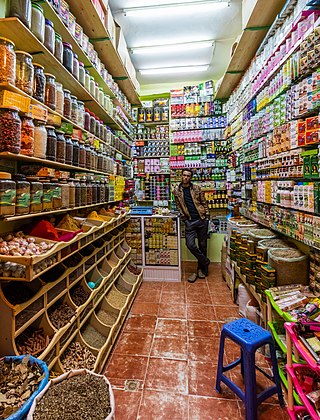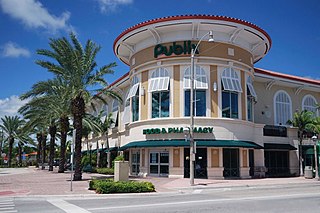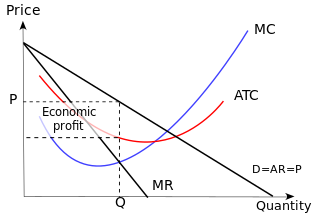
A convenience store, bodega, convenience shop, corner store or corner shop is a small retail store that stocks a range of everyday items such as tea, coffee, groceries, fruits, vegetables, snacks, confectionery, soft drinks, ice creams, tobacco products, lottery tickets, over-the-counter drugs, toiletries, newspapers and magazines. In some jurisdictions, convenience stores are licensed to sell alcoholic drinks, although many jurisdictions limit such beverages to those with relatively low alcohol content, like beer and wine. The stores may also offer money order and wire transfer services, along with the use of a fax machine or photocopier for a small per-copy cost. Some also sell tickets or recharge smart cards, e.g. OPUS cards in Montreal or include a small deli. They differ from general stores and village shops in that they are not in a rural location and are used as a convenient supplement to larger stores.
Collusion is a deceitful agreement or secret cooperation between two or more parties to limit open competition by deceiving, misleading or defrauding others of their legal right. Collusion is not always considered illegal. It can be used to attain objectives forbidden by law; for example, by defrauding or gaining an unfair market advantage. It is an agreement among firms or individuals to divide a market, set prices, limit production or limit opportunities. It can involve "unions, wage fixing, kickbacks, or misrepresenting the independence of the relationship between the colluding parties". In legal terms, all acts effected by collusion are considered void.

Retail is the sale of goods and services to consumers, in contrast to wholesaling, which is sale to business or institutional customers. A retailer purchases goods in large quantities from manufacturers, directly or through a wholesaler, and then sells in smaller quantities to consumers for a profit. Retailers are the final link in the supply chain from producers to consumers.
In economics and marketing, product differentiation is the process of distinguishing a product or service from others to make it more attractive to a particular target market. This involves differentiating it from competitors' products as well as from a firm's other products. The concept was proposed by Edward Chamberlin in his 1933 book, The Theory of Monopolistic Competition.
Rational ignorance is refraining from acquiring knowledge when the supposed cost of educating oneself on an issue exceeds the expected potential benefit that the knowledge would provide.

The Kroger Company, or simply Kroger, is an American retail company that operates supermarkets and multi-department stores throughout the United States.

Water Tower Place is a large urban, mixed-use development comprising a 758,000 sq ft (70,400 m2) shopping mall in a 74-story skyscraper in Chicago, Illinois, United States. The mall is located at 835 North Michigan Avenue, along the Magnificent Mile. It is named after the nearby Chicago Water Tower, and is owned by affiliates of Brookfield Property Partners. As reported by the Chicago Suntimes, Brookfield Property Partners handed the keys to the project back to their lender, MetLife, owing to numerous retail vacancies following the closing of Macy's and the impact of COVID and increasing crime along the Magnificent Mile.

Publix Super Markets, Inc., commonly known as Publix, is an employee-owned American supermarket chain headquartered in Lakeland, Florida. Founded in 1930 by George W. Jenkins, Publix is a private corporation that is wholly owned by present and past employees and members of the Jenkins family. Publix operates throughout the Southeastern United States, with locations in Florida (865), Georgia (211), Alabama (90), South Carolina (69), Tennessee (57), North Carolina (54), Virginia (20), and Kentucky (1). Kentucky is the most recent addition to the Publix footprint, with the company's first store in that state having opened on January 10, 2024 in Louisville.

In economics, a luxury good is a good for which demand increases more than what is proportional as income rises, so that expenditures on the good become a greater proportion of overall spending. Luxury goods are in contrast to necessity goods, where demand increases proportionally less than income. Luxury goods is often used synonymously with superior goods.

A general merchant store is a rural or small-town store that carries a general line of merchandise. It carries a broad selection of merchandise, sometimes in a small space, where people from the town and surrounding rural areas come to purchase all their general goods. The store carries routine stock and obtains special orders from warehouses. It differs from a convenience store or corner shop in that it will be the main shop for the community rather than a convenient supplement.
In political science and social choice theory, the median voter theorem states that if voters and candidates are distributed along a one-dimensional spectrum and voters have single peaked preferences, any voting method satisfying the Condorcet criterion will elect the candidate preferred by the median voter.

Non-price competition is a marketing strategy "in which one firm tries to distinguish its product or service from competing products on the basis of attributes like design and workmanship". It often occurs in imperfectly competitive markets because it exists between two or more producers that sell goods and services at the same prices but compete to increase their respective market shares through non-price measures such as marketing schemes and greater quality. It is a form of competition that requires firms to focus on product differentiation instead of pricing strategies among competitors. Such differentiation measures allowing for firms to distinguish themselves, and their products from competitors, may include, offering superb quality of service, extensive distribution, customer focus, or any sustainable competitive advantage other than price. When price controls are not present, the set of competitive equilibria naturally correspond to the state of natural outcomes in Hatfield and Milgrom's two-sided matching with contracts model.

Giant Eagle, Inc. and stylized as giant eagle) is an American supermarket chain with stores in Pennsylvania, Ohio, West Virginia, Indiana, and Maryland. The company was founded in 1918 in Pittsburgh, Pennsylvania, and incorporated on August 31, 1931. Supermarket News ranked Giant Eagle 21st on the "Top 75 North American Food Retailers" based on sales of $11 billion. In 2021, it was the 36th-largest privately held company, as determined by Forbes. Based on 2005 revenue, Giant Eagle is the 49th-largest retailer in the United States. As of summer 2014, the company had approximately $9.9 billion in annual sales. As of fall 2023, Giant Eagle, Inc. had 496 stores across the portfolio: 211 supermarkets 8 standalone pharmacies, 274 fuel station/convenience stores under the GetGo banner, and three standalone car wash under the WetGo banner. The company is headquartered in an office park in the Pittsburgh suburb of O'Hara Township.
In economics, a location model or spatial model refers to any monopolistic competition model that demonstrates consumer preference for particular brands of goods and their locations. Examples of location models include Hotelling's Location Model, Salop's Circle Model, and hybrid variations.
Service Merchandise was a retail chain of catalog showrooms carrying jewelry, toys, sporting goods and electronics. The company, which first began in 1934 as a five-and-dime store, was in existence for 68 years before ceasing operations in 2002.

Brick and mortar is an organization or business with a physical presence in a building or other structure. The term brick-and-mortar business is often used to refer to a company that possesses or leases retail shops, factory production facilities, or warehouses for its operations. More specifically, in the jargon of e-commerce businesses in the 2000s, brick-and-mortar businesses are companies that have a physical presence and offer face-to-face customer experiences.
The H. & S. Pogue Company was a Cincinnati, Ohio based department store chain founded by two brothers, Henry and Samuel Pogue. They came from County Cavan, Northern Ireland, to Cincinnati and worked in their uncle's dry goods store. They later were able to buy him out and H. & S. Pogue Dry Goods Company was established in 1863 at 111 West Fifth Street. Brothers Thomas, Joseph, and William Pogue would eventually join the enterprise.

Journelle is a luxury lingerie company based in New York. Founded by Claire Chambers, the name Journelle comes from the archaic French word “journellement" meaning “daily”, as lingerie is designed to be worn every day.

D'Agostino Supermarkets once a family-owned supermarket chain in the New York City area, is now owned by Gristedes. The store was founded in 1932 by brothers Pasquale and Nicola D'Agostino, in the pioneering phase of the supermarket industry. At D'Agostino's peak in the 1990s, the chain operated at 26 locations in New York City and adjacent Westchester County, with annual sales exceeding $200 million. By 2016 under financial pressure, D'Agostino's consolidated to nine stores, all in Manhattan, and sold a controlling interest to John Catsimatidis, owner of Gristedes.

Haymarket in Boston is an open-air market on Blackstone, Hanover, and North Streets, next to the Rose Fitzgerald Kennedy Greenway between the North End and Government Center.













